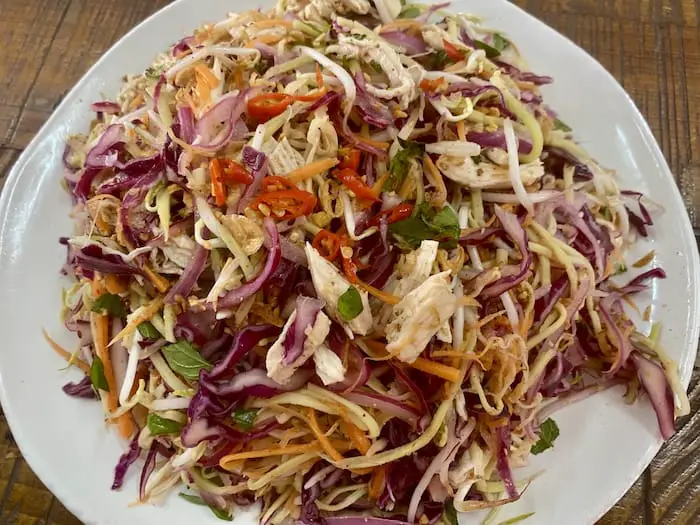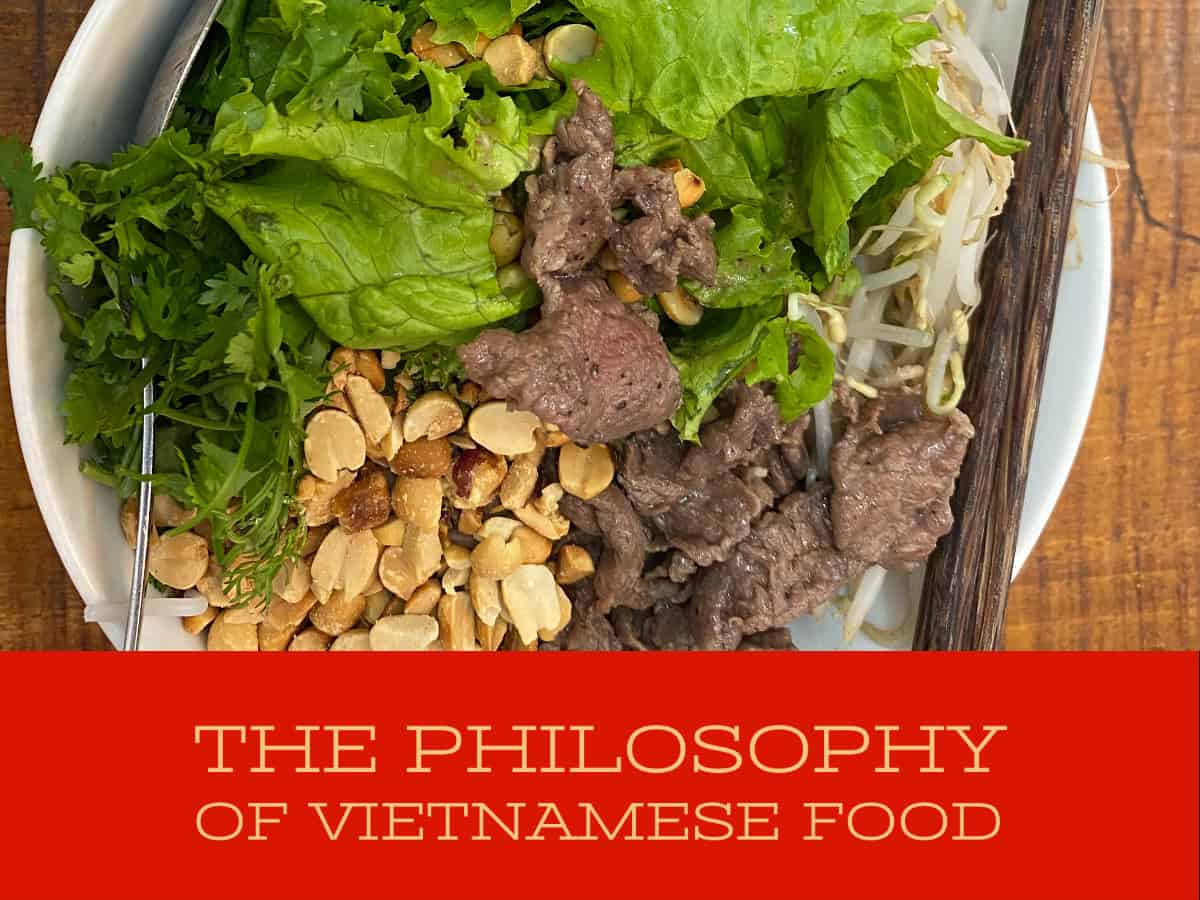Vietnamese food continues to gain popularity. One of the main reasons for this increase in popularity is that it uses fresh ingredients and is bursting with flavors. Vietnamese food is the kind of food that touches all your senses at once.
Vietnamese food uses the five elements of philosophy: wood, fire, earth, metal, and water. These five elements touch our senses of sight, hearing, smell, taste, and touch. They also take into account the color and flavor combinations of Vietnamese food. When you understand the importance of the five elements of wood, fire, earth, metal, and water, you also understand a lot about Vietnamese cuisine.
Table of Contents
- The Philosophy of Vietnamese Food
- The 5 Elements of Wood, Fire, Earth, Metal, and Water
- The 5 Elements and Vietnamese Food Explained
- Vietnamese Chicken, Carrot, Green Mango, and Red Cabbage Salad
- Related Content
The Philosophy of Vietnamese Food
Many people may think that Vietnamese food’s taste and food combinations are just how the Vietnamese have cooked for centuries. Though they have cooked or eaten that way for centuries, there is a philosophy behind the sight, hearing, smell, taste, and touch you experience when you eat Vietnamese food.
The philosophy for Vietnamese food is based on five essential elements of Wood, Fire, Earth, Metal, and Water. These five elements come from the Chinese philosophy that describes the interaction and relationship between everything, including food.
The 5 Elements of Wood, Fire, Earth, Metal, and Water
These five elements of wood, fire, earth, metal, and water first appeared in China in what is known as the Spring and Autumn period from 770-476 BC. The philosophy of the five elements is used a lot in Chinese medicine. Philosophy, Fengshui, fortune-telling, and martial arts.
China has controlled Vietnam for over 1,000 years. (You can read the blog A Brief History of Vietnam, What You Should Know by clicking here to learn more about the Chinese era of Vietnamese rule.
The five elements look at how each of these five elements interacts. That is known as the yin and yang or how these elements react together or against each other.
The 5 Elements and Vietnamese Food Explained
The Vietnamese adopted the 5 elements of philosophy in their culture in many ways. But one way is in their foods and how they cook their food.
In Vietnamese food, the dishes should have a balance between all our senses. The chart below shows how each of these elements works with Vietnamese food.
| Wood | Fire | Earth | Metal | Water | |
| Taste | Sour | Bitter | Sweet | Spicy | Salty |
| Senses | Eyes | Tongue | Mouth | Nose | Ear |
| Color | Green | Red | Yellow | White | Black |
Vietnamese Food And Your Taste Buds And The 5 Elements
The taste for the five elements is key to Vietnamese cuisine. Many Vietnamese dishes use limes, fish sauce, salt, pepper, vinegar, and sugar. This is because each of these ingredients works together with the five elements of taste.
Below is a chart of common ingredients of Vietnamese cuisine and how they work with the 5 elements of taste.
| Wood | Fire | Earth | Metal | Water | |
| Taste | Sour | Bitter | Sweet | Spicy | Salty |
| Ingredients | Limes | Vinegar | Sugar | Red Chili | Salt, Fish Sauce |
These taste five elements also correspond to our five body organs: the gall bladder, small intestine, large intestine, stomach, and urinary bladder. This is back to this belief in that the five elements are somehow interconnected.
Vietnamese Food And Your Senses And The 5 Elements
Dishes in Vietnam should appeal to our five senses: sight, hearing, smell, taste, and touch. This usually happens through the food itself. For example, the sight would be the bright and vibrant colors of the food.
The hearing would include sounds like crispy ingredients, as the rice crackers add a cracking noise when you eat the salad or the fried onions that crunch in a salad. The smell is the aroma of the food. The taste is having the sweet yet sour flavors burst in your mouth. And finally, the touch is when some food elements are crispy, and others are soft.
Here is how each of the five elements works in Vietnamese cuisine and common Vietnamese ingredients.
| Wood | Fire | Earth | Metal | Water | |
| Senses | Eyes | Tongue | Mouth | Nose | Ears |
| Food | Color of food | Crispy and soft elements of the food | Sweet and sour taste | Smell | Cracking or crisp sounds |
Vietnamese Food And Your Colors Senses And The 5 Elements
Color combinations of Vietnamese food are also essential. The dishes should try to have five colors: white (metal), green (wood), yellow (earth), red (fire), and black (water) in all their dishes.
Here are some common ingredients and the color of the food for each of the five elements:
| Wood | Fire | Earth | Metal | Water | |
| Colors | Green | Red | Yellow | White | Black |
| Ingredients | Mint leaves | Red Chilis | Mango | Bean Sprouts | Black Pepper |
Vietnamese Chicken, Carrot, Green Mango, and Red Cabbage Salad

We love this example of the Vietnamese Green Mango, Carrot, and Red Cabbage salad as an example of these 5 elements in Vietnamese cuisine.
The Vietnamese chicken, carrot, green mango, and red cabbage salad has 5 elements as their ingredients and taste:
- Wood – Sour: Limes
- Fire-Bitter: Onions
- Earth – Sweet: Sugar
- Metal – Spicy: Red Chilies
- Water – Salty: Salt and Fish Sauce
The Vietnamese chicken, carrot, green mango, and red cabbage salad has 5 elements as their ingredients and senses:
- Wood- Eyes: The vibrant color of the salad
- Fire – Tongue: Soft and crispy elements of the salad.
- Earth – Mouth: Has a sweet and sour taste.
- Metal – Nose: The salad has a very good smell or aroma.
- Water – Ears: Peanuts and cracking of the rice crackers as you eat the salad.
The Vietnamese chicken, carrot, green mango, and red cabbage salad has the 5 elements as their ingredients and color, with
- Wood – Green: Fresh Mint
- Fire – Red: Red Chilies
- Earth- Yellow: Green Mango (and Chicken)
- Metal – White: Bean Sprouts
- Water – Black: Black Pepper
If you want to make this recipe, you can check out the recipe for the Vietnamese Chicken, Carrot, Green Mango, and Red Cabbage Salad by clicking here.
To fully understand the Vietnamese philosophy of Vietnamese cuisine, you need to understand how food is affected by the five elements of wood, fire, earth, metal, and wood. These five elements ensure that Vietnamese food bursts with flavors that touch all our senses.
At A Bus On A Dusty Road, we talk about travel, life, and ex-pat living. We are all about “Living Life As A Global Citizen.” We explore social, cultural, and economic issues and travel.
We would love to have you be part of our community. Sign up for our newsletter to keep up-to-date by clicking here. If you have any questions, you can contact me, Anita, by clicking here.
Listen to our Podcast called Dusty Roads. You can find it on all major podcast platforms. Try out listening to one of our podcasts by clicking here.
Subscribe to our A Bus On A Dusty Road YouTube Channel filled with great videos and information by clicking here.
Related Content
Why is Thai Food So Spicy?
History has shown us that Thai food is spicy as Thai food combines a few kinds of cuisines, such as Indian, Chinese, and Portuguese. The Indians brought curry to Thailand. The Chinese taught the Thais how to cook using a wok, and the Portuguese traded in a lot of fruits and vegetables, including red chili.
You can find out more by reading our blog Why is Thai Food So Spicy? A Bit of History by clicking here.
What is the Asian Stir-fry Cooking Method?
The Asian stir-fry cooking method is a technique of cooking that started in China but has since spread to the rest of Asia, including Vietnam. The food is cooked using the quick-cook method by constantly stirring the ingredients as it is cooking. It is an effortless and healthy cooking technique that anyone can master.
You can learn more about the stir-fry method by reading our blog on What is the Asian Stir-fry Cooking Method? by clicking here.

